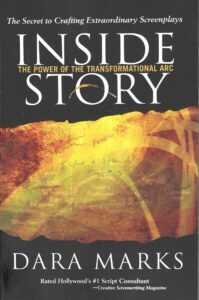Marks Illustrates Story

Dara Marks. 2007. Inside Story: The Power of the Transformational Arc. Studio City, CA: Three Mountain Press.
Review by Stephen W. Hiemstra
Confession. I read writing craft books when I am editing a manuscript to motivate deeper reflection and identify areas of weakness. Fiction is oodles more complex than nonfiction. The attempt is to create a multidimensional composition through the use of situations, descriptions, and narratives that both inform, entertain, and evoke an emotional response in the reader. With each new project and each new craft book, the hope is that my craft will improve.
IntroductionDara Marks’ Inside Story: The Power of the Transformational Arc begins with this statement:
“Inside Story offers techniques and methods to help writers identify and stay focused on deeper thematic and emotional dimensions that are necessary to create a more natural or organic story structure.” (1-2)
She goes on to observe:
“The place that lies between what we know and what we are coming to know about ourselves and others is sometimes referred to as the borderland. …. A writer who relies entirely on intuition rarely makes it to the borderland because what comes from the unconscious will generally stay there unless it is confronted and examined.” (3)
Aristotle observed that drama imitates life (5). Marks views writing as an attempt to plumb into our very souls and scrape through the dark side of our consciousness. In other words, our own self-knowledge limits our craft, which suggests that advancing our craft—writing oneself out—has the potential to expand our self-understanding.
Marks illustrates her points drawing from well-known films. While many authors have done this, her case studies go beyond broad film critiques to focus on turning points and the emotions evoked.
Background and OrganizationDara Marks has a doctorate from Pacifica Graduate Institute in Carpinteria, California. She works as a script consultant and has written several books.
Marks writes in ten chapters, divided into two parts, preceded by an introduction and followed by an epilogue. The chapters are:
Introduction
PART I: LAYING A STRONG FOUNDATION
In the beginning: The WordPlot: Lights, camera, action!Character: Getting to the heartTheme: Defining IntentionThe fatal flaw: Bring character to lifePART II: BUILDING THE ARC OF CHARCTER
Inside structure: Swimming in the deep endAct I: Fade in…Act II—Part one: What goes up…Act II—Part two: …Must come downAct III: Down and Dirty (xi-xiii)Epilogue
These chapters are followed by a glossary, filmography, and an index.
The ABCs of ScreenwritingBetter than other authors, Marks outlines how the plot is served by the subplots. She writes: “Whereas the plot carries the line of action, the subplot(s) carry the emotional and thematic content.” (34) She describes the plot as the A story, while the emotional and thematic subplots are the B story and the relational subplot constitutes the C story. Marks notes that “the protagonist is the character who not only carries the external goal of the plot, but also the internal goals of the subplots.” (61)
In a fully developed screenplay the C story must be resolved to unwind the B story and these two internal subplots are essential to allow resolution of the A story. Marks describes this journey as the transformational arc (323). When the B and C stories are underdeveloped or missing entirely, the A story appears unsupported or just plain hollow. When the B and C stories fail to coordinate with the A story, the audience can walk away confused.
Fatal FlawMuch of the journey in a well-crafted screenplay arises out of a fatal flaw because without it a character has no room to grow. Marks sees “The fatal flaw [as] a struggle within a character to maintain a survival system long after it has outlived its usefulness.” (114)
The dependency of childhood must necessarily exist because the child is unable to care for themselves, but must be abandoned for the adolescent to enter adulthood. The survival system of the child therefore no longer sustains the adolescent and must be given up. In adulthood, this dependency is not only unseemly, it impedes development of adult relationships and the assumption of activities required for adults to survive. Thus, this childhood dependency is a fatal flaw in an adult.
ThemeShe sees “theme [as] what gives meaning to the activity of the plot and purpose to the movement of the characters.” (73) Her view of conflict is nothing more than “something is out of balance.” This implies that theme provides a “sort of mission statement.” (81) Theme is most obvious at the midpoint of the screenplay where a “moment of enlightenment” takes place. (235)
AssessmentDara Marks’ Inside Story: The Power of the Transformational Arc covers territory familiar to many writing books in a powerfully unfamiliar way. Marks succeeds in making the ABC movements in developing character arc in concrete terms, where competing books are much more abstract. Authors will want to read this book to develop their craft; recreational readers may enjoy the movie critiques.
FootnotesDaraMarks.com.
I owe this expression to Professor James Shaffer formerly of Michigan State University.
Marks Illustrates StoryAlso see:Haidt Analyzes Pervasive Mental IllnessGoleman: Emotional Intelligence Brings LightBooks, Films, and MinistryOther ways to engage online:Author site: http://www.StephenWHiemstra.net Publisher site: http://www.T2Pneuma.com Newsletter at: https://bit.ly/Sum_end_25 , Signup
The post Marks Illustrates Story appeared first on T2Pneuma.net.



